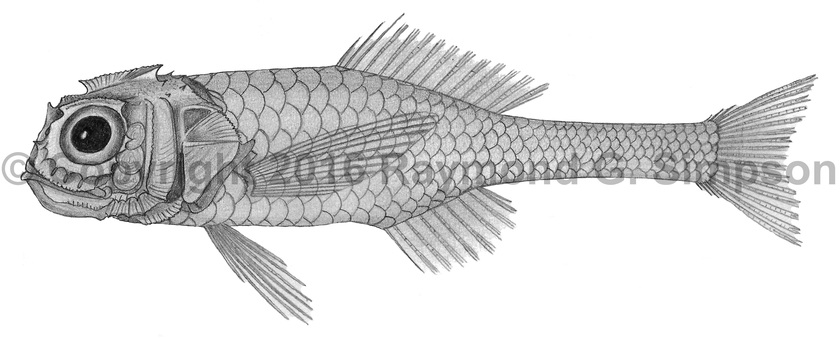
Common Name
Bigeye Ridgehead
Year Described
Lütken, 1878
Identification
Dorsal Fin: III, 11
Anal Fin: I, 8-9
Pectoral Fin: 13-14
Pelvic Fin: I, 7
Caudal Fin: 9-10 branched, 2-4 procurrent rays
Lateral Scale Rows: 34-35
Gill Rakers: 26-28
Vertebrae: 28-29
Head with heavy bony ridging and pitting. A conspicuous anterior spine in front of eye and bony crest present on top of head (characteristic of Poromitra). Caudal peduncle longer relative to body than other species in genus. Rear margin of mouth extends beyond orbit. Eye large. Preopercle with spines in the lower margin, variable spines on upper margin, and spined through the angle. Anterior preopercular margin with ridges at a right angle. Opercle with serrated upper margin. Anal fin origin under the 2-4th from last dorsal ray. Pectoral fin extends to rear dorsal fin base. Pelvic fin origin anterior to pectoral fin base. Four scales on cheek. Pyloric caeca number 8.
Color
Body light brown with a darker head
Size
Maximum size to 62mm SL
Habitat
Captured from 150-1075m, with adults in the deeper water and juveniles toward the surface.
Range
Widespread in the open north Atlantic from well off Canada to the Sargasso Sea, and the Gulf of Mexico to Brazil.
References
Kotlyar, A. N. 2010. Revision of the genus Poromitra (Melamphaidae): Part 6. Species of the P. megalops group. Journal of Ichthyology v. 50 (no. 3): 231-245.
McEachran, J.D. and J.D. Fechhelm. 1998. Fishes of the Gulf of Mexico. Volume 1: Myxiniformes to Gasterosteiformes. University of Texas Press, Austin. i-viii + 1-1112.
Moore, J. A., K. E. Hartel, J. E. Craddock, and J. K. Galbraith. 2003. An annotated list of deepwater fishes from off the New England region, with new area records. Northeastern Naturalist 10(2): 159-248.
Other Notes
This is highly distinctive from other Poromitra species in the Atlantic and is part of a like-named species complex of two other Indo-Pacific and eastern Pacific species. The combination of long caudal peduncle, large eye, and 4 cheek scales is unique to the P. megalops complex (Kotlyar, 2010).